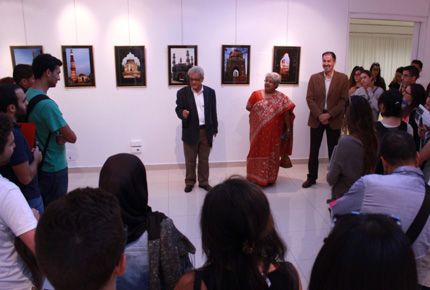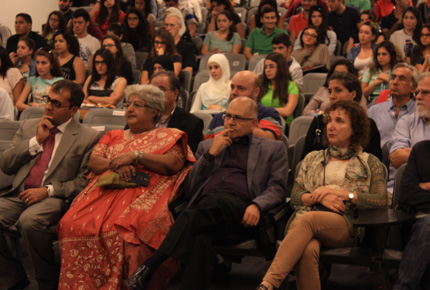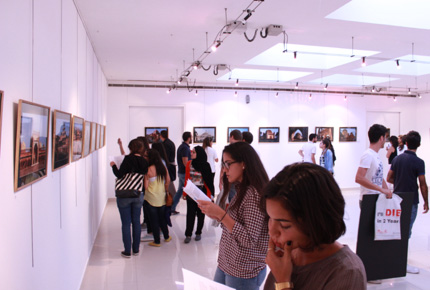Ratish Nanda brings the story of the restoration of the Tomb of Humayun to LAU
Tomb restoration project highlights India’s rich Islamic heritage … and aids the community, becoming an example to the world.

The lecture inaugurated an exhibition of photographs shot by Binoy K. Behl on “Islamic Monuments in India.”

As Nanda explained, craftsmen repaired the tomb using the same tools as the original builders did some 450 years ago.
Legend has it that the Mughal Emperor Humayun, son of Babur, was in his beloved library when he heard the call to prayer. His arms laden with books, the Emperor tried to kneel, but tripped on his gown, falling down the library stairs to his death.
Humayun’s widow Biga Begum had a mausoleum built in his memory, commissioning the largest Islamic tomb in the entire Muslim world. Over one hundred years later, the Emperor’s great-grandson — Shah Jahan — would go on to use the monument as an inspiration for the grand marbled mausoleum of Taj Mahal in Agra, which he built in memory of his wife.
The recent restoration of Humayun’s tomb was the topic of a lecture recently given at LAU by renowned Indian architect Ratish Nanda. The lecture inaugurated an exhibition of photographs shot by Binoy K. Behl on “Islamic Monuments in India.” LAU’s Institute of Islamic Art and Architecture at the School of Architecture and Design organized the events in collaboration with the Embassy of India in Lebanon. Both School of Architecture and Design Dean Elie Haddad and Indian Ambassador Anita Nayar attended the event.
Nanda — who is India Projects Director for the Aga Khan Historic Cities Program of the Aga Khan Trust for Culture — led the restoration of the tomb. “The Trust for Culture’s main philosophy is to look at culture as an asset; to look at culture as a tool for socio-economic development,” he says. “What we are trying to do with our projects across the Islamic world is demonstrate how conservation and development can go hand in hand.”
Nanda and his team faced many challenges, among them the lost art of traditional restoration. “India has been building great monuments for three thousand years, but used traditional systems of conservation that were not documented,” says Nanda. “When the British colonized India, traditional systems of preservation were dismantled. Masons and craftsmen were replaced by engineers and architects who did not know how to build such buildings.” This loss resulted in shoddy and damaging solutions to maintenance problems at the site of Humayun’s tomb. For example, the restoration team had to remove a million kilos of concrete from the roof that previous restorers had used in an attempt to keep water out of the tomb.
One of the social benefits of the project involved reviving the knowledge of traditional restoration systems within the local community. Nanda’s team brought craftsmen to the center of the process and provided two thousand man-hours of employment for local stonecutters, masons and carpenters. These craftsmen repaired the tomb using the same tools as the original builders did some 450 years ago.
Humayun’s tomb is located in one of the densest populated areas in Delhi and the local community was purposefully targeted as part of the restoration project. “Without improving the quality of people’s lives, it would be meaningless to do all this work,” says Nanda. The initiative included a major socio-economic component, focusing on empowering women, improving sanitation conditions, educating children and bringing life to the tomb’s surroundings.
The successful project is today a case study and many cities around the world are considering it as a model to follow, even in Lebanon. “Discussions are currently underway with the Indian embassy to make use of Ratish Nanda’s expertise in the form of a workshop about rehabilitation possibilities in the southern city of Sour,” explains Dr. Abdallah Kahil, director of LAU’s Institute of Islamic Art & Architecture.
The lecture and photo exhibition are part of a series of events organized for the launching of the Mu’taz and Rada Sawwaf Master’s in Islamic Art and Architecture that is managed by the Institute of Islamic Art and Architecture at LAU School of Architecture and Design.
More
Latest Stories
- Student Pharmacists: Serving Through Uncertainty
- Research Highlight: Dr. Elie Bouri on Cryptocurrency
- The Threat of Gram-Negative Bacteremia on Public Health in Lebanon
- A Frontline Like No Other: Students Take Action
- Fostering Healthy Connections in Times of Conflict
- The Crucial Role of Anesthesiologists in Mass Casualty Response
- Another Groundbreaking Discovery by the LAU Genetics Team
- LAU Faculty Recognized Regionally for Teaching Innovation


